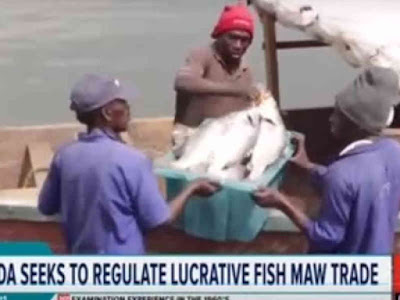Uganda Seeks to Regulate Fish Maw Trade
pada tanggal
Tuesday, January 22, 2019
 KAMPALA, LELEMUKU.COM - At the Gaba landing site in Kampala, fishermen dock their boats filled with both tilapia and Nile perch.
KAMPALA, LELEMUKU.COM - At the Gaba landing site in Kampala, fishermen dock their boats filled with both tilapia and Nile perch.Waiting along the shores, donning white gum boots and white coats, fish traders wait to offload the Nile perch that has turned profitable for many traders.
The fish’s commodity, known as a swim bladder, is used as an aphrodisiac in China and is now being recognized by the Ugandan government as water gold, but fishermen at the forefront say they are being exploited.
A study by the Lake Victoria Fisheries Organization has shown that a growing appetite in Asia has seen the former waste by-product becoming a multi-million-dollar export.
Idrisa Walusimbi began working as a fisherman 20 years ago. Now, he has his own boat and is chairman of the fish protection unit. He says in the early 1990s, Nile perch fish maw would be fried and eaten by locals. But lately, the Chinese market has made it more lucrative, especially for the exporter.
“You find that from the lowest fisherman, as you know, that he gains, but not so much. Then you find the middleman gains more, and the trader above gains even more, the levels keep increasing and the ones that profit the most are the final local buyer and exporter,” Walusimbi said.
Uganda, Kenya, and Tanzania collectively earn $86 million from trading the commodity. Uganda alone earned $40 million in 2017 as the largest exporter of the Nile perch swim bladder to China.
Vincent Ssempijja, Uganda’s minister for agriculture, animal industry and fisheries, says fish maw is a new item that needs to be regulated.
“That’s why we want to regulate it, so that our fish farmers and of course the fish mongers and the fisheries sector really, benefit from this very lucrative business. Yes, it’s certainly a new type of gold, so we need to look at it more critically,” Ssempijja said.
International prices for dry maw range between $450 and $1,000 per kilogram, depending on the size, quality and market strength. Fish sold to locals have the swim bladders taken out and sold for between $107 to $214 per kilogram.
At the Gaba landing site, fish processing companies have trucks loaded with the Nile Perch fish maw left intact.
The Lake Victoria Fish Organization in its report advises that the fish maw be recognized as a separate commodity from fish. Walugembe George, a fisherman, says he wishes there was a standard price so they too could benefit.
"We have always known that it’s a saleable commodity, but we sell it at low prices. So, we have been exploited. Why do the prices hike and then slump?" he asked.
The Ugandan government is currently consulting and discussing a fisheries and aquaculture bill that calls for the fish maw to be one of the products that should be regulated. (VOA)

